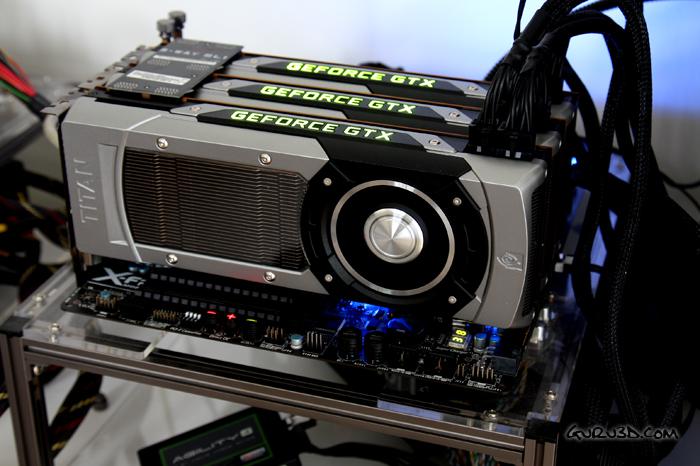Final words and conclusion
Final Words & Conclusion
Alright, now how did you like that?
I know that some if not most of you are battling with the price of the GTX Titan versus its performance relative to the GTX 690. We can't argue with you there, if you don't mind the complications that multi-GPU solutions have then surely you'd get a little more boom-boom-pow out of the GTX 690.
There are of course people that hate multi-gpu solutions, and it is for these guys that the move towards Titan makes a lot of sense. Multi-GPU wise we need to be realistic though, the 6 GB framebuffer is gonna help in the near future with the toughest titles, no doubt there.
The Recommendation
If you are going to stick towards one monitor then the reality is that with graphics cards so powerful only 2-way SLI is a viable solution (you use the hottest games that are GPU limited). So up-to 2560x1600 that 3rd card really isn't gonna matter a lot, unless you like to break synthetic benchmark records.
Once you pass a monitor resolution of 2560x1440 or 2560x1600 that's where a third card starts to make a difference, and as you have seen, not everywhere, but it'll make a difference here and there though.
- Our recommendation as such is simple, with a single monitor setup like 1920x1080/1200 your maximum number of GTX Titan cards should be a maximum of one.
- Now, if you have that nice 30" monitor with a 2560x1440 or 2560x1600 resolution, that's where a 2nd card could matter.
- Once you reach multi monitor gaming. If you're going to be using 3 monitors at 5760x1080/1200 that's where a 3rd card would make some sense. Realistically though two are already sufficient.
Processor power then. Each time we publish an article on multi-GPU solutions we read it on the forums, "you should be using a faster test platform". Hence we used a X79 / Core i7 3960 Extreme processor clocked at 4600 MHz. These two components alone cost 1200 EUR (excluding the liquid cooling), with multi-GPU gaming they do show an increase in performance. You do need to wonder though if the 10~15% performance increase in lower resolutions really justifies that money, but obviously if you can afford two or three GTX Titan cards, you probably will go for the best and fastest infrastructure as well.
So performance wise, up-to 2-way very little negative can be said about the GeForce GTX Titan set up in SLI. 3-way however is a lot harder to justify if we talk about pure game performance, and not synthetic benchmarking.
Noise and Heat
The fun part of this all is that the GPUs will hardly heat up. See depending on your configuration the temperature target protection of the GTX Titan will keep these cards at 80 Degrees C. As explained, in a poorly ventilated chassis this can have an effect though, since the temperature is the top priority the cards could clock down a bit once they want to pass that 80 degrees C target.
Noise wise really it's as good as it can be. Up-to two cards you can hear a bit of airflow under full GPU stres and with three cards in the same conditions you'll be able to hear a fair bit of airflow. Nothing rather irritating or annoying though. Three GPUs equals 3x the heat and airflow that needs to be exhausted. But X79 / 3960X / Quad Channel memory / 3 monitors / 3x Titan... my bet is that you are going for a pretty enthusiast well ventilated PC chassis as well, right ?
Power Consumption
Power consumption then, honestly it's not that bad. Two GPUs consume roughly 450~500 Watts whilst three GPUs use roughly 700~750, add to that the rest of your system (processor, chipset peripherals) at say 200 Watts and you'll find yourself in the 900 Watt power consumption region tops when playing a hefty game with three cards. If you plan to overclock CPU and GPUs, then make sure you add at least another 200W onto your PSU requirements. Keep that in mind okay? Increased voltages means increased power consumption.
To be able to operate two or more cards in SLI mode you'll need a SLI compatible motherboard, most if not all Intel X58, P67, Z68, Z77 and X79 motherboards are SLI certified, some P55 motherboards as well. AMD's 900 series carry SLI support as well. Carefully check that out before opting for your SLI preference and thus before purchasing multiple cards.
Driver compatibility - In all our tests we had no driver issues whatsoever. All games worked straight out of the box. The one exception is the new 3DMark (2013) hence the lacking results. But other then that seriously props to that. SLI has been well refined by Nvidia over the years.
So there you have it, three GeForce GTX Titan cards set up in SLI will still cost you say 3000 EUR alone, for that money you'll gain a truckload of performance kicking your configuration into the highest gear performance wise. We'll admit it though, if you are on a single monitor, there's just no need for it unless you like to break 3DMark scores. Once you reach multi-monitor gaming with three monitors, there's where a 2/3-way configuration makes more sense. And that also makes 3-way SLI with the GTX Titan only something to consider for the ones that plan to go awfully extreme. But that's never been any different of course.
We hope you enjoyed this review, we had a blast making it with the cool gear at hads of course. Until next time.
BTW, we have multiple articles on GeForce GTX Titan, just so that you know:
- GeForce GTX Titan Reference review
- GeForce GTX Titan 3-way SLI and Multi monitor review
- GeForce GTX Titan Overclock review
Recommended Downloads
- Sign up to receive a notice when we publish a new article
- Or go back to Guru3D's front page


